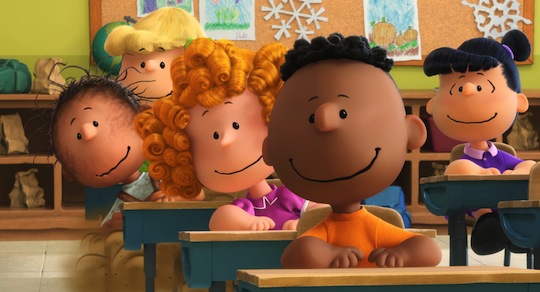{No compensation was received for this post. I attended a press conference which facilitated the writing of this post}
Some of my fondest memories of my father are the simplest…putting together the many art projects required by the private school I attended and watching our favorite films on repeat Saturday nights. My father was a huge fan of the Peanuts Comic Strips, and Sunday mornings before church, we’d laugh over them together. Watching the trailer for The Peanuts Movie with my kids a few weeks ago brought back so many memories of my time with my father. And while the film’s visuals are modern, vibrant and immersive, I can already venture to say that the filmmakers have preserved the humor and heart of these beloved characters.

Last week, I spent the day in Santa Rosa, California, home of the late “Sparky.” After walking through the Charles M. Schulz Museum and Research Center, which is dedicated to preserving the legacy he created, I had the privilege of speaking to the filmmakers and talent from The Peanuts Movie. Every moment of the day evoked nostalgia, and it was inspiring to glean insight into Schulz’s life and his unique gift for using art and humor to entertain and shed light on growing up from a child’s perspective along with the more subtle light he shed on more global social issues. One of the more poignant moments from the day was our time with Harriet Glickman, the Los Angeles school teacher who encouraged Schulz to integrate minority characters into his comic strip.
It was 1968, a tumultuous time in America, a country grieving the assassination of Dr. Martin Luther King, Jr. and the tension over race relations had climaxed. It was at this time Glickman wrote to Schulz about the lack of minority representation in the Peanuts comic strips. Because of its success, Glickman believed that Schulz could help bridge that gap and positively influence race relations across the country. What Glickman didn’t know at the time was that Schulz and his fellow cartoonists were aware of the lack of minority characters, but were challenged with doing so without being patronizing to a specific culture. Passion and holding to her convictions, Glickman reached out to her community of African American friends for candid feedback regarding such inclusion. Glickman’s correspondence with Schulz alleviated his concerns and in the Summer of 1968, he drew the first episode introducing the character of Franklin.
On July 31, 1968, Charlie Brown, while on summer vacation with Sally, Linus and Lucy at the beach is seen looking out at the ocean, when Franklin approached, having found Charlie Brown’s beach ball.

Thus marked the introduction of the first African American character into the world of Peanuts and the first minority character in a major, mainstream comic strip. His conviction was met with some opposition, but Schulz was unwavering and Franklin persisted as a central character for the duration of the Peanuts comic strip.
Every story has a backstory, and learning about the passion and conviction that fueled the creation of Franklin was inspirational and breathed depth into my perspective on the film. Mar Mar (Marleik Walker) voices the beloved Franklin in The Peanuts Movie, and together with Harriet Glickman, they talked about the endearing significance of the Peanuts characters and why the latest film will resonate with families.
Like many children, Mar Mar recalls growing up around the Peanuts comic strips. When he secured the role of Franklin, he decided that he had to find a way to make his voice sound unique while merging the old Franklin’s voice with a newer voice. Mar Mar’s research included listening to Franklin’s voice and then weaving the sophistication he perceived with his own flair.

Kind and a “jack of all trades,” Mar Mar finds the character of Franklin to be “amazing.” He believes the film will resonate with families because of how it makes you feel at the end. “It doesn’t make you feel sad or mad or happy, or any of those emotions. It just gives you a warm feeling and you feel good about yourself.”
Humble, yet resolute, Glickman talked about how wonderful it has been to watch the character of Franklin evolve and continue to resonate with our culture today. The latest film has breathed new life into this backstory of how Franklin came to be, and like John Lewis (founder of John Lewis Department Stores) said, “if you see something that needs to be fixed, you have to speak up.” Glickman’s hope is that his message endures.

For adults like myself, the sheer joy of reliving my childhood through the new film with my own children will compel me to see it. It’s endearing quality rests in the fact that the Peanuts characters are children who are scared and have insecurities. They go through the same things today that they did 50 years ago and their friendship and how they approach life is what makes them so timeless.

The Peanuts Movie debuts in theaters November 6, 2015. You can also keep up with the Peanuts gang on their respective social media channels:
Like ‘The Peanuts Movie’ on Facebook
Follow on Twitter, Google+, Instagram
Subscribe on YouTube
- Discover Luxury at Sonesta Irvine: Your Ideal Staycation - August 8, 2024
- CHOC Walk Returns to the Disneyland Resort – Special Events and Ways to Support - June 28, 2023
- Beastly Ball Returns to the Los Angeles Zoo - May 8, 2023







Leave a Reply